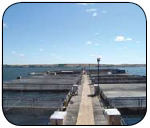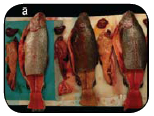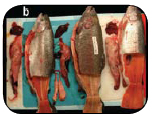Aquaculture Collaborative Research and Development Program (ACRDP) Fact Sheet
Issue 1 - April 2009
Summary
When trout are fed with high energy / low phosphorus feed, it is possible to obtain a reduction in food conversion rate and phosphorus waste. Although new Canadian feeds are higher in price, the improved feed conversion ratios afford an overall reduced cost of feeding fish per unit of gain, while also reducing the total phosphorus discharge. Based on these studies, the utilisation of high-performance feeds by Canadian trout growers is recommended.
Introduction
Since the late 1980's the Danish trout feed industry has been regulated as to the composition of the grower feeds that are allowed to be used by farmers. The feed composition regulations specify the maximum amounts of phosphorus, nitrogen and ash, the minimum levels of energy and digestibility, and the maximum feed conversion ratios that are acceptable.
Trout farmers in Saskatchewan, Alberta and Ontario collaborated with researchers at Laval University in Quebec City to test whether trout fed with high energy Danish feed had a better feed conversion ratio (FCR: grams of food fed per gram of fish weight gain) and reduced environmental impact (particularly phosphorus discharge) than fish fed with feeds traditionally used by Canadian trout growers. Newly formulated feeds from Canadian manufacturers were also compared to the Danish feed.
Methods
The main components of this study were:
- Compositional analysis of Danish and Canadian feeds at Laval University, QC
- Laboratory feed trials at the Alma Aquaculture Research Station (AARS), ON
- Commercial farm scale feed trials at the following locations:
- Wild West Steelhead, SK; lake cage system
- Smoky Trout Farm, AB; recirculation system
- Ackenberry Trout Farm, AB, recirculation system
The Danish feed used was BioMar Ecolife 19TM, which is commercially produced, regularly used on commercial Danish farms and complies with Danish environmental regulations.
Each feed was tested in multiple tanks at the lab location to ensure a higher level of statistical validity and trends were verified on commercial farms (Table 1).
Table 1
| DANISH | NEW-CAN. | TRAD.-CAN. | ||||
|---|---|---|---|---|---|---|
| # of feeds | # tanks / feed | # of feeds | # tanks / feed | # of feeds | # tanks/ feed | |
| Laboratory (AARS) | 1 | 3 | 2 | 3 | 1 | 3 |
| Commercial Farms | ||||||
| Wild West Steelhead | 1 | 2 | 1 | 2 | 1 | 2 |
| Smoky Trout Farm | 1 | 2 | 1 | 2 | 1 | 2 |
| Ackenberry Trout Farm | 1 | 1 | 2 | 1 | 1 | 1 |
The Canadian feeds used in the experiments were those generally used by the commercial farms that were part of the trials:
Skretting OrientTM
Ewos PacificaTM
Martin Mills Hi-EnergyTM
Unifeed WWS 45/19TM
Skretting Orient LPTM
Ewos HarmonyTM
Skretting Orient LP™ and Ewos Harmony™ represented the newly formulated, Canadian-manufactured feeds used in this experiment.


Figure 1.
Two sites used for field trials - Alma Aquaculture Research Station (Top) and Wild West Steelhead (Bottom).
All of the feeds used during the laboratory and commercial feed trials were analysed to determine their composition and compare it with the composition reported by the feed producers. The analyses were carried out using standard methods in the laboratories of the Department of Animal Science, Laval University.
Analyses included:
- Dry matter
- Phosphorus content
- Crude protein content
- Ash content
- Lipids content
- Energy content
Results
Feed Analysis
In general, the analysis of the feed composition indicated that the contents measured in the lab and the values from the company labels were similar. Some minor differences were detected but were not considered significant from a nutritional standpoint.
Feed Conversion Efficiency
The feed conversion ratios (FCR) of the Danish feed were lower (better) than those from traditional Canadian feeds. The newly formulated Canadian feeds showed FCRs that were generally intermediate between the FCRs from the other feeds (Table 2).
Table 2
| FEED TYPE | |||
|---|---|---|---|
| DANISH | NEW-CAN. | TRAD.-CAN. | |
| LABORATORY (AARS) | |||
| Rainbow trout (750-1500g) |
1.13 | 1.22 | 1.45 |
| Difference | -22% | -16% | - |
| COMMERCIAL FARMS | |||
| Rainbow trout (650-1000g) |
1.19 | - | 1.6 |
| Difference | -26% | - | - |
| Rainbow trout (60-160g) |
0.91 | 0.99 | 1.00 |
| Difference | -9% | -1% | - |
| Average of differences | -19%% | -9% | - |
Phosphorus Waste Production
Trout fed with the new Canadian feeds and the Danish feed released far less phosphorus than trout fed with the traditional Canadian feed (Table 3).
Table 3
Total phosphorus waste (g per kg of trout produced) for different types of feed and facility, and the difference when compared with values from traditional Canadian feeds.
| FEED TYPE | |||
|---|---|---|---|
| DANISH | NEW-CAN. | TRAD.-CAN. | |
| LABORATORY (AARS) | |||
| Rainbow trout (750-1500g) |
6.11 | 7.51 | 10.99 |
| Difference | -44% | -32% | - |
| COMMERCIAL FARMS | |||
| Rainbow trout (650-1000g) |
7.28 | - | 1.6 |
| Difference | -45% | - | - |
| Rainbow trout (60-160g) |
4.15 | 5.08 | 8.5 |
| Difference | -51% | -40% | - |
| Average of differences | -47% | -36% | - |
Thermal Growth Coefficient
Because the trout at the different sites were fed at markedly different temperatures, their growth was converted to a Thermal Growth Coefficient (TGC), which is the amount of growth per temperature per day. Trout fed with Danish feed had higher TGC than trout fed with Canadian feed. The type of Canadian feed did not seem to have an impact on the TGC.
Colouration
Trout fed with the Danish feed had a much higher level of colouration than the trout fed with the traditional or newly formulated Canadian feeds (Figure 2).


Figure 2.
Difference of flesh colouration between trout fed with Danish feed (a) and with traditional Canadian feed (b).
Conclusions
This study showed that the use of high-performance feeds improved the growth performances (FCR, TGC) of rainbow trout, along with environmental performance in terms of reduction of phosphorus discharge in the effluent. Canadian feed manufacturers are continuing to improve the performance of their feeds. Access to high-performing domestic feeds will help Canadian trout growers achieve the goal of reducing the environmental impact of their farms while keeping the cost of production as competitive as possible.
This ACRDP project (CA-05-01-002) was a collaborative effort among Fisheries and Oceans Canada (DFO Science), Laval University and the Northern Ontario Aquaculture Association (including Wild West Steelhead, SK; Smoky Trout Farm, AB; and Ackenberry Trout Farm, AB).
The lead scientist on this project, Dr. Grant Vandenberg, can be contacted at Grant.Vandenberg@san.ulaval.ca.
For further information on this and other ACRDP projects, visit: /aquaculture/acrdp-pcrda/index-eng.htm.
Published by:
Fisheries and Oceans Canada
Ottawa, Ontario
K1A 0E6F
© Her Majesty the Queen in Right of Canada 2009
ISSN 1919-6806 (Print),
ISSN 1919-6814 (Online)
DFO/2008-1493
- Date modified: